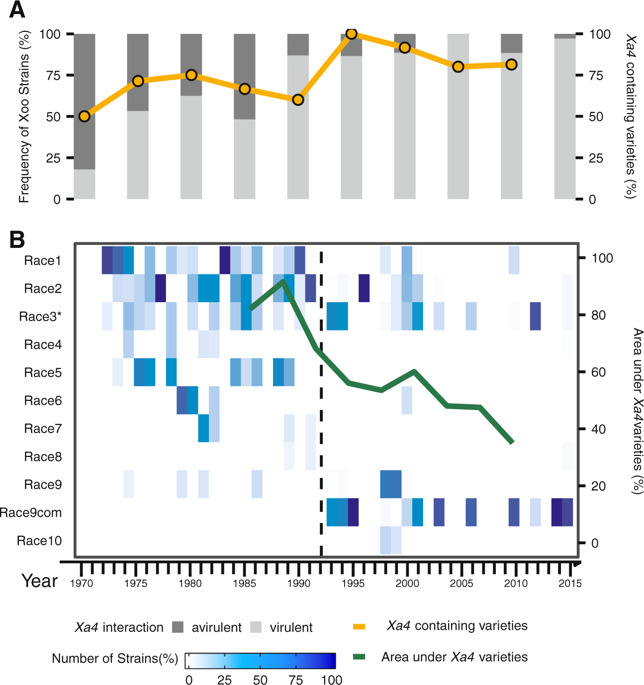Our official English website, www.x-mol.net, welcomes your feedback! (Note: you will need to create a separate account there.)
The Green Revolution shaped the population structure of the rice pathogen Xanthomonas oryzae pv. oryzae.
The ISME Journal ( IF 11.0 ) Pub Date : 2019-10-30 , DOI: 10.1038/s41396-019-0545-2 Ian Lorenzo Quibod 1 , Genelou Atieza-Grande 1, 2 , Eula Gems Oreiro 1 , Denice Palmos 3 , Marian Hanna Nguyen 1 , Sapphire Thea Coronejo 1 , Ei Ei Aung 1 , Cipto Nugroho 1, 4 , Veronica Roman-Reyna 1 , Maria Ruby Burgos 1 , Pauline Capistrano 1 , Sylvestre G Dossa 1, 5 , Geoffrey Onaga 1 , Cynthia Saloma 3 , Casiana Vera Cruz 1 , Ricardo Oliva 1
The ISME Journal ( IF 11.0 ) Pub Date : 2019-10-30 , DOI: 10.1038/s41396-019-0545-2 Ian Lorenzo Quibod 1 , Genelou Atieza-Grande 1, 2 , Eula Gems Oreiro 1 , Denice Palmos 3 , Marian Hanna Nguyen 1 , Sapphire Thea Coronejo 1 , Ei Ei Aung 1 , Cipto Nugroho 1, 4 , Veronica Roman-Reyna 1 , Maria Ruby Burgos 1 , Pauline Capistrano 1 , Sylvestre G Dossa 1, 5 , Geoffrey Onaga 1 , Cynthia Saloma 3 , Casiana Vera Cruz 1 , Ricardo Oliva 1
Affiliation

|
The impact of modern agriculture on the evolutionary trajectory of plant pathogens is a central question for crop sustainability. The Green Revolution replaced traditional rice landraces with high-yielding varieties, creating a uniform selection pressure that allows measuring the effect of such intervention. In this study, we analyzed a unique historical pathogen record to assess the impact of a major resistance gene, Xa4, in the population structure of Xanthomonas oryzae pv. oryzae (Xoo) collected in the Philippines in a span of 40 years. After the deployment of Xa4 in the early 1960s, the emergence of virulent pathogen groups was associated with the increasing adoption of rice varieties carrying Xa4, which reached 80% of the total planted area. Whole genomes analysis of a representative sample suggested six major pathogen groups with distinctive signatures of selection in genes related to secretion system, cell-wall degradation, lipopolysaccharide production, and detoxification of host defense components. Association genetics also suggested that each population might evolve different mechanisms to adapt to Xa4. Interestingly, we found evidence of strong selective sweep affecting several populations in the mid-1980s, suggesting a major bottleneck that coincides with the peak of Xa4 deployment in the archipelago. Our study highlights how modern agricultural practices facilitate the adaptation of pathogens to overcome the effects of standard crop improvement efforts.
中文翻译:

绿色革命塑造了水稻病原体 Xanthomonas oryzae pv. 的种群结构。稻米。
现代农业对植物病原体进化轨迹的影响是作物可持续性的核心问题。绿色革命用高产品种取代了传统的水稻地方品种,创造了统一的选择压力,可以衡量这种干预的效果。在这项研究中,我们分析了一个独特的历史病原体记录,以评估主要抗性基因 Xa4 在稻黄单胞菌 pv 种群结构中的影响。oryzae (Xoo) 在 40 年内在菲律宾收集。在 1960 年代初期部署 Xa4 后,剧毒病原体群的出现与越来越多地采用携带 Xa4 的水稻品种有关,该品种达到总种植面积的 80%。对代表性样本的全基因组分析表明,六个主要病原体组在与分泌系统、细胞壁降解、脂多糖产生和宿主防御成分解毒相关的基因中具有独特的选择特征。关联遗传学还表明,每个种群可能会进化出不同的机制来适应 Xa4。有趣的是,我们发现了在 1980 年代中期影响几个种群的强选择性扫描的证据,这表明一个主要瓶颈与 Xa4 在群岛部署的高峰期相吻合。我们的研究强调了现代农业实践如何促进病原体的适应,以克服标准作物改良工作的影响。和宿主防御成分的解毒。关联遗传学还表明,每个种群可能会进化出不同的机制来适应 Xa4。有趣的是,我们发现了在 1980 年代中期影响几个种群的强选择性扫描的证据,这表明一个主要瓶颈与 Xa4 在群岛部署的高峰期相吻合。我们的研究强调了现代农业实践如何促进病原体的适应,以克服标准作物改良工作的影响。和宿主防御成分的解毒。关联遗传学还表明,每个种群可能会进化出不同的机制来适应 Xa4。有趣的是,我们发现了在 1980 年代中期影响几个种群的强选择性扫描的证据,这表明一个主要瓶颈与 Xa4 在群岛部署的高峰期相吻合。我们的研究强调了现代农业实践如何促进病原体的适应,以克服标准作物改良工作的影响。这表明一个主要瓶颈与 Xa4 在群岛部署的高峰期相吻合。我们的研究强调了现代农业实践如何促进病原体的适应,以克服标准作物改良工作的影响。这表明一个主要瓶颈与 Xa4 在群岛部署的高峰期相吻合。我们的研究强调了现代农业实践如何促进病原体的适应,以克服标准作物改良工作的影响。
更新日期:2020-01-17
中文翻译:

绿色革命塑造了水稻病原体 Xanthomonas oryzae pv. 的种群结构。稻米。
现代农业对植物病原体进化轨迹的影响是作物可持续性的核心问题。绿色革命用高产品种取代了传统的水稻地方品种,创造了统一的选择压力,可以衡量这种干预的效果。在这项研究中,我们分析了一个独特的历史病原体记录,以评估主要抗性基因 Xa4 在稻黄单胞菌 pv 种群结构中的影响。oryzae (Xoo) 在 40 年内在菲律宾收集。在 1960 年代初期部署 Xa4 后,剧毒病原体群的出现与越来越多地采用携带 Xa4 的水稻品种有关,该品种达到总种植面积的 80%。对代表性样本的全基因组分析表明,六个主要病原体组在与分泌系统、细胞壁降解、脂多糖产生和宿主防御成分解毒相关的基因中具有独特的选择特征。关联遗传学还表明,每个种群可能会进化出不同的机制来适应 Xa4。有趣的是,我们发现了在 1980 年代中期影响几个种群的强选择性扫描的证据,这表明一个主要瓶颈与 Xa4 在群岛部署的高峰期相吻合。我们的研究强调了现代农业实践如何促进病原体的适应,以克服标准作物改良工作的影响。和宿主防御成分的解毒。关联遗传学还表明,每个种群可能会进化出不同的机制来适应 Xa4。有趣的是,我们发现了在 1980 年代中期影响几个种群的强选择性扫描的证据,这表明一个主要瓶颈与 Xa4 在群岛部署的高峰期相吻合。我们的研究强调了现代农业实践如何促进病原体的适应,以克服标准作物改良工作的影响。和宿主防御成分的解毒。关联遗传学还表明,每个种群可能会进化出不同的机制来适应 Xa4。有趣的是,我们发现了在 1980 年代中期影响几个种群的强选择性扫描的证据,这表明一个主要瓶颈与 Xa4 在群岛部署的高峰期相吻合。我们的研究强调了现代农业实践如何促进病原体的适应,以克服标准作物改良工作的影响。这表明一个主要瓶颈与 Xa4 在群岛部署的高峰期相吻合。我们的研究强调了现代农业实践如何促进病原体的适应,以克服标准作物改良工作的影响。这表明一个主要瓶颈与 Xa4 在群岛部署的高峰期相吻合。我们的研究强调了现代农业实践如何促进病原体的适应,以克服标准作物改良工作的影响。



























 京公网安备 11010802027423号
京公网安备 11010802027423号